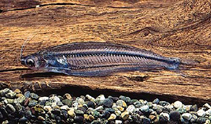| Family: |
Schilbeidae (Schilbid catfishes) |
| Max. size: |
7.5 cm SL (male/unsexed) |
| Environment: |
demersal; freshwater; brackish |
| Distribution: |
Africa: Ogooué and Djoungou River drainages (Gabon) southwards to the drainages of the Kouilou and Loeme (Republic of Congo), Chiloango, Luculla and Quanza (Angola) and the lower Congo River (Ref. 3570, 78218, 81643). |
| Diagnosis: |
Dorsal spines (total): -0; Dorsal soft rays (total): -0; Anal spines: -0; Anal soft rays: 51-68. Diagnosis: adipose fin present; inner side of pectoral spine feebly serrated, with small to very small serrations; 51-68 soft anal fin rays; vomerine teeth usually absent; a dark triangular blotch at base of caudal fin (Ref. 43912, 81643).
Description: 7-8 branched pectoral fin rays; 41-45 nonfused vertebrae; gill rakers long; 9-11 branchiostegal rays on one side of head; head rounded; snout reaching slightly beyond lower jaw; caudal peduncle slightly deeper than long or somewhat longer than deep (Ref. 43912). In many respects this species resembles Parailia pellucida and both species might even be considered as dubiously distinct or are at least very closely related; P. occidentalis can be distinguished from P. pellucida by the presence of a black triangular spot at the base of the anal fin in the former (which, however, also sometimes appears in specimens of P. pellucida), by the lower number of anal fin rays (51-68 in P. occidentalis against 60-78 in P. pellucida), lower number of non-fused vertebrae (41-45 in P. occidentalis versus 44-45 in P. pellucida) and by the fact that small vomerine teeth are present in P. pellucida while they are absent in P. occidentalis (at least in the specimens used for osteological preparations); moreover in examined specimens of P. occidentalis the inner side of the pectoral spine was always feebly to very feebly serrated, while these serrations are generally much better developed in P. pellucida (Ref. 43912).
Coloration: in life: pale, more or less transparent/translucent, with small triangular spot at base of caudal fin (Ref. 43912, 81643). Preserved specimens: head and back covered with small brown-black spots; fine mid-lateral line terminates in small spot at base of caudal fin; band of chromatophores sometimes present along anal fin base; pelvics colourless, pectoral fin often mottled, anal also sometimes mottled (Ref. 43912, 81643). Some specimens with faint grey stripe along median caudal fin rays (Ref. 43912). |
| Biology: |
Confined to large and moderate rivers; sometimes penetrates into estuaries; gregarious schooling species, such schools probably an important prey for several larger carnivorous species (Ref. 43912). Oviparous, eggs are unguarded (Ref. 205). Maximum TL reported 85 mm (Ref. 43912). |
| IUCN Red List Status: |
Least Concern (LC); Date assessed: 01 May 2009 Ref. (130435)
|
| Threat to humans: |
harmless |
Source and more info: www.fishbase.org. For personal, classroom, and other internal use only. Not for publication.
